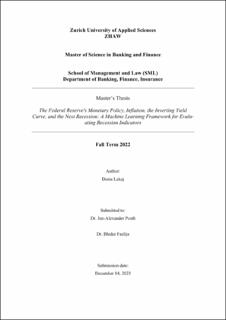Please use this identifier to cite or link to this item:
https://doi.org/10.21256/zhaw-29357Full metadata record
| DC Field | Value | Language |
|---|---|---|
| dc.contributor.advisor | Posth, Jan-Alexander | - |
| dc.contributor.advisor | Fazlija, Bledar | - |
| dc.contributor.author | Lekaj, Denis | - |
| dc.date.accessioned | 2023-12-08T15:17:48Z | - |
| dc.date.available | 2023-12-08T15:17:48Z | - |
| dc.date.issued | 2023 | - |
| dc.identifier.uri | https://digitalcollection.zhaw.ch/handle/11475/29357 | - |
| dc.description.abstract | After years and years of easy money, interest rates in the US are moving up again the yield curve is inverting. While Quantitative Easing is signalled to end in Europe, too, global debt levels are very high, and inflation is rapidly picking up around the globe. How will the US economy respond to rising rates and the end of easy money? The goal of the thesis is to understand the mechanism behind interest rate levels, the form of the yield curve, inflation, and the economy as well as the stock market. The policy of the FED needs to be understood and analysed given the background of its historical actions. Furthermore, a machine learning framework is built for trying to evaluate recession indicators. This thesis revealed that the monetary policy in the Fed aims to achieve its statutory mandate objectives: maximum employment, stable prices, and moderate long-term interest rates. As the Fed was recently criticized for not achieving its goals of stability and low inflation. This resulted several advocated changes, including alterations to the policy and unconventional monetary policy, that became during the last decade very important. According to the literature, expansionary (contractionary) monetary policy impacts the stock market positively (negatively). Based on the literature examined in this thesis, it can be concluded that as inflation increased, the Fed hat to increase interest rates as a reaction of high inflation by affecting the money supply and its real impact on the FFR. Longer-term interest rates and asset classes show a responsiveness to changes in the existing and targeted FFR. In this regard, consumer expectations regarding the future development of the key interest rate impact both medium- and longer-term interest rates. If borrowers and lenders currently assume that the FOMC will lower the policy rate substantially in the coming years, medium- and long-term interest rates will reflect these expectations. As a result, interest rates will be lower than they otherwise would have been. Moreover, households and businesses make purchasing decisions based on long-term interest rates, which affect economic performance, employment, and inflation. Yield curves and their respective spreads can be good indicators for recession prediction. This thesis showed that with less data, using only the 10y and 3m Treasury yield, the corresponding spread, as well as the NBER recession dataset. ML frameworks are ideally suited for this purpose. In conclusion it can be said that the yield curve alone is not structural but is dependent upon monetary policy. For that reason, other macroeconomic variables have predictive power and can help improve recession forecasting accuracy. | de_CH |
| dc.format.extent | 150 | de_CH |
| dc.language.iso | en | de_CH |
| dc.publisher | ZHAW Zürcher Hochschule für Angewandte Wissenschaften | de_CH |
| dc.rights | http://creativecommons.org/licenses/by-nc-nd/4.0/ | de_CH |
| dc.subject.ddc | 332: Finanzwirtschaft | de_CH |
| dc.title | The Federal Reserve's monetary policy, inflation, the inverting yield curve, and the next recession : a machine learning framework for evaluating recession indicators | de_CH |
| dc.type | Thesis: Master | de_CH |
| dcterms.type | Text | de_CH |
| zhaw.departement | School of Management and Law | de_CH |
| zhaw.publisher.place | Winterthur | de_CH |
| dc.identifier.doi | 10.21256/zhaw-29357 | - |
| zhaw.originated.zhaw | Yes | de_CH |
| Appears in collections: | MSc Banking and Finance | |
Files in This Item:
| File | Description | Size | Format | |
|---|---|---|---|---|
| 2023_Lekaj_Denis_MSc_BF.pdf | 3.79 MB | Adobe PDF |  View/Open |
Show simple item record
Lekaj, D. (2023). The Federal Reserve’s monetary policy, inflation, the inverting yield curve, and the next recession : a machine learning framework for evaluating recession indicators [Master’s thesis, ZHAW Zürcher Hochschule für Angewandte Wissenschaften]. https://doi.org/10.21256/zhaw-29357
Lekaj, D. (2023) The Federal Reserve’s monetary policy, inflation, the inverting yield curve, and the next recession : a machine learning framework for evaluating recession indicators. Master’s thesis. ZHAW Zürcher Hochschule für Angewandte Wissenschaften. Available at: https://doi.org/10.21256/zhaw-29357.
D. Lekaj, “The Federal Reserve’s monetary policy, inflation, the inverting yield curve, and the next recession : a machine learning framework for evaluating recession indicators,” Master’s thesis, ZHAW Zürcher Hochschule für Angewandte Wissenschaften, Winterthur, 2023. doi: 10.21256/zhaw-29357.
LEKAJ, Denis, 2023. The Federal Reserve’s monetary policy, inflation, the inverting yield curve, and the next recession : a machine learning framework for evaluating recession indicators. Master’s thesis. Winterthur: ZHAW Zürcher Hochschule für Angewandte Wissenschaften
Lekaj, Denis. 2023. “The Federal Reserve’s Monetary Policy, Inflation, the Inverting Yield Curve, and the next Recession : A Machine Learning Framework for Evaluating Recession Indicators.” Master’s thesis, Winterthur: ZHAW Zürcher Hochschule für Angewandte Wissenschaften. https://doi.org/10.21256/zhaw-29357.
Lekaj, Denis. The Federal Reserve’s Monetary Policy, Inflation, the Inverting Yield Curve, and the next Recession : A Machine Learning Framework for Evaluating Recession Indicators. ZHAW Zürcher Hochschule für Angewandte Wissenschaften, 2023, https://doi.org/10.21256/zhaw-29357.
Items in DSpace are protected by copyright, with all rights reserved, unless otherwise indicated.